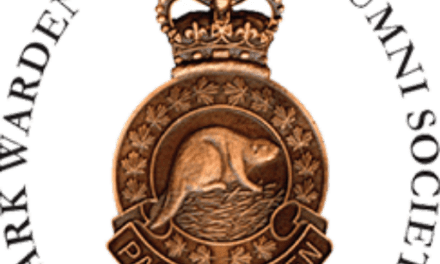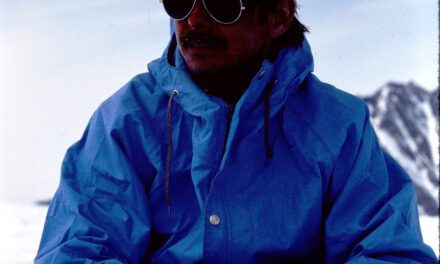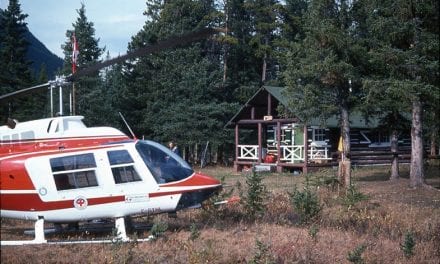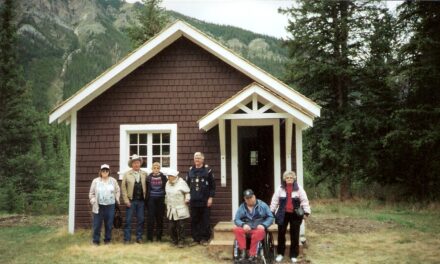This Oral History interview was funded in part by a research grant received in 2021 from the Government of Alberta through the Alberta Historical Resources Foundation.
Park Warden Alumni Society of Alberta
Oral History Phase 11 Spring 2021
Phone Interview with George Mercer
Date/time: March 24, 2021 @1100
Interviewed by Monique Hunkeler
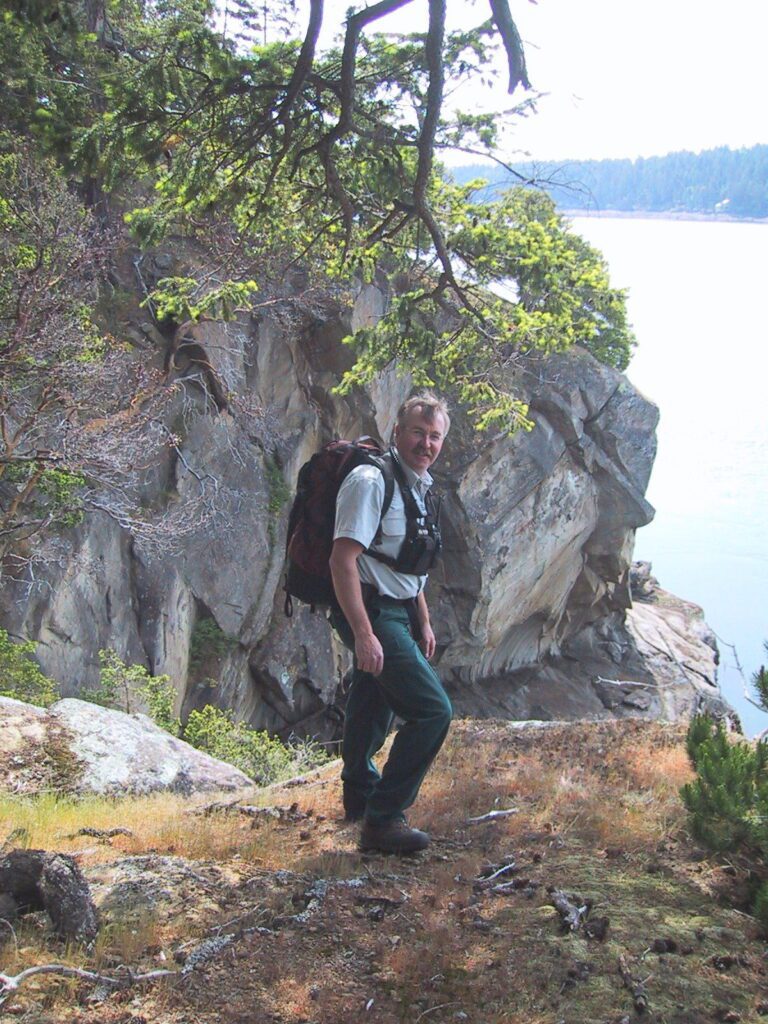
George on Tumbo
Place and date of birth?
GM: Gander Newfoundland on May 1, 1957
MH: Where did you grow up?
GM: Technically there, I was born and raised there until my teens but I always say I grew up in Terra Nova National Park. Lived in Gander until I started university at age 17/18 and then off and on worked in Terra Nova where I worked and felt that I grew up and got a few clues about the world.
MH: How did you become involved in the Warden Service? Which national park did you start working in?
GM: Initially I started university in St. John’s. I was in Marine Biology and hoped to work in biology but driving back and forth to university from Gander to St. John’s took us through Terra Nova and I would always see the warden trucks there and wondered what the men in the Stetsons did and also wondered what National Parks were all about so that kind of led me to applying for a job in Terra Nova and ultimately getting into the Warden Service. Terra Nova was my first National Park. When they first started the vehicle permits back in 1975 and when they were building gateways to charge people vehicle fees I got a job in Terra Nova as a gateway attendant. During the next few summers I worked there as a gateway and campground attendant as well as a labourer for a couple of winters and ended up working as an interpreter for a couple of years in the park.
MH: What made you want to join the Warden Service? 0230:
GM: I was always interested in having a career working with wildlife and then just getting involved with parks and getting an appreciation for what the parks did, that perked my interest. When I initially started in Terra Nova, I lived in a park bunkhouse but when they closed those, one of the ladies who worked with me, Mary Harris, wife of Lloyd Harris, one of the Park Wardens, offered me a place to stay for the summer. Living with them gave me a better idea of what Lloyd did as a Park Warden and then what the Park Wardens did in general. So that got my interest in becoming a National Park Warden.
MH: What different parks did you work in? How did they compare? Do you have a favourite? 0335:
GW: Terra Nova was the first, then Fundy National Park and Cape Bretton Highlands, Wood Buffalo, Jasper and Gulf Islands in that order. In many respects there were no comparisons because each one presented its own challenges and opportunities. Wood Buffalo was probably the most challenging because of the huge issues facing the Park and the small staff that had to deal with them. That was probably the one Park where we were given so many responsibilities for programs. In southern parks, Wardens wouldn’t get to work on similar projects until they had many years under their belt so the benefit of going North was that you got a lot of experience in a relatively short amount of time. The Parks don’t really compare but Wood Buffalo stands out. It really is a phenomenal Park. But all six Parks I worked in were so unique and challenging in their own ways and presented so many different opportunities. I don’t really have a favourite, I liked them all. But I would say I maybe have a soft spot for Wood Buffalo, largely because I think it was one of the most underrated Parks in the system at the time and it was dealing with issues like logging in the Park that I think wouldn’t have been tolerated in the southern National Parks.
MH: What were some of your main responsibilities over the years? 510:
GM: They varied a lot for sure depending on the Park and the stage I was at in my career. Initially in the Atlantic Parks, I got heavily involved in Law Enforcement as well as Resource Management. In those Parks, more so than other places I’d been, I really saw how all the components of the job came together in doing resource work and Law Enforcement that supported that. But when we moved to the north, to Wood Buffalo, my time was almost completely taken up with Resource and Ecosystem Management issues including Bison, Peregrine Falcons, Whooping Cranes and the Peace Athabasca Delta. In Jasper I was assigned to larger landscape issues like woodland caribou protection, issues that got us speaking with our neighbours in both British Columbia and Alberta and then dealing with some of the trans-boundary development issues like the Cheviot mine on the Jasper Boundary. Also in Jasper I got heavily involved in human use monitoring related to protecting the wildlife corridors in and around the Town of Jasper. After Jasper we came to the Gulf Islands. Jan and I both took demotions to come here and I went back into Warden Operations again, but after a short time I moved into the Ecological Monitoring Position at Gulf Islands and that’s where I ended my career.
As I worked in the outfit over the years, I certainly saw the evolution of the organization and the need to get better knowledge and have more knowledgeable people involved, especially where the science was taking off into bigger roles. So when we were in the North, I returned to University of Alberta to finish my degree in Conservation Biology. From that point on I was able to play a larger and more active role in the Ecological Sciences area. I didn’t really put my Marine Biology training from Memorial University to use per se but coming back to the Gulf Islands was a very fitting ending to my career because I always wanted to get back to the coast and work around marine areas. As the monitoring ecologist, I did get involved with marine issues again and several components of the monitoring program were focused on marine aspects of Gulf Island National Park Reserve. So from Newfoundland and my interest in marine issues I kind of did come full circle, ending up on the coast instead, but still working in boats again and in a marine environment.
MH: What did you like / Dislike about being a warden? 850 :
GM: Growing up I was always captivated by wildlife so working with wildlife issues and the environment was my main interest, an interest motivated by writers like Rachel Carson and Farley Mowatt. So the career with the Warden Service really opened that door and provided an opportunity to do hands on work. Initially, a lot of the work was being done in Parks by the Canadian Wildlife Service, and the Wardens were kind of like the labourers for them, which we probably resented a little bit at the time because I felt we had the capability to do more. But anyways, as we took on more of the duties, I liked the idea of designing and carrying out field programs around wildlife and analysing and interpreting the data and then taking it right to the end, communicating the results so people understood what we were finding out from our work, including parks staff, managers and the public, and our peers in other organizations. And I really did like the hands on work with wildlife including radio and GPS collaring, but over time, I felt that the way that science was evolving, there were more non-intrusive ways of collecting information that were less stressful on animals and new technologies that offered a lot of options that limited direct contact with wildlife. I was a big proponent through the years of getting away from directly handling wildlife and trying to use less intrusive monitoring to get a better handle on what the wildlife was doing in our Parks. In Jasper, when we started collaring caribou and wolves I was blown away by the ability to collect GPS collar data and be able to show people what caribou were doing on a daily basis, compared to when you did traditional wildlife work and would only pick up a collar location every month maybe. But when you could show people what a species was doing, how it was spending its day and put that information on maps and showed the folks, it really opened a lot of people’s eyes.
Not like: I would say that there is not a lot that I didn’t like but often it was what I refer to as battling with people, including Parks staff sometimes, who I felt didn’t have the same understanding or commitment to protecting what the parks were set aside to protect. I called it “the battle within”. Earlier in my career I spent a lot of time battling poachers but during the later part of my career I felt that I was battling management a lot of the time. But to be fair, I probably didn’t have an appreciation or understanding of the challenges they were facing. I did find that you got tired of fighting over things that you felt should have just been accepted, this is what the Parks had set aside to protect so why are we taking some of these actions that impact those things. There were a lot of managers back in the day that struggled with some of those decisions and they sought advice but sometimes they had to make a call that probably in their heart really didn’t want to do. I do feel strongly that with the government change a few years back, with Harper coming in, there were a lot of the people going into management that weren’t in tune with Parks. They came from other organizations, and while that’s not necessarily a bad thing since new blood is good, they didn’t have the field experience of the day to day running of the outfit and that caused a lot of challenges for the people who had been around for a while. This seemed to happen in other organizations as well.
MH: What were some of your more memorable events as a Warden? 1515:
GM: In the early days, the highlight for me was being successful in dealing with some of the more notorious poachers that we’d dealt with in the east. Some guys in Cape Breton who’d never been caught before and finally dealing with them and having them convicted in court. And having people in the community realize what these people were up to and the devastation they were causing in our Parks was kind of a stand out event because it really started to change people’s attitudes. Accepted activities from the past were no longer being accepted in the community and locals began to understand that these folks were out for themselves and doing irreparable damage to the Parks. And the other thing that really stood out further along in my career was helping to put an end to logging in Wood Buffalo National Park. There was a team of us younger Wardens there who started questioning why we were allowing this to happen in a National Park. Ultimately we had a part to play in shutting down the timber berth in Wood Buffalo National Park and also helping to shut down the idea of the proposed slaughter of buffalo in the park, that was a huge issue in the late 80s for us. It was based on the notion that Bison were infected with tuberculosis and brucellosis but there were also a lot of egos driving that whole program, not only to get rid of Bison in the Park by also, Alberta was pushing ranching into Northern Alberta into the boreal forest and there were a lot of different agendas that were coming to play against Wood Buffalo. We always felt that Wood Buffalo was taking it on the chin in so many ways and deserved better.
MH: Can you tell me about any rescue/wildlife stories that stick out in your memory? 1745:
GM: This isn’t going to be your typical story but it goes back to the Wood Buffalo situation. There were a small group of us up there who got together and created a mini-revolt within the ranks of Parks Canada when the Bison slaughter was put forward. We kind of put our jobs on the line. We went to the media and we wanted to stop what we saw was a pretty misguided and potentially devastating management action to kill all the parks Bison. And not just with the Bison, we helped put Wood Buffalo on the map Nationally because we made connections with some well-known media folks who went on to help get the word out about what was happening in the park. Ed Struzik was a key person with respect to this. At the time he was a reporter with the Edmonton Journal and for 4 weeks running, he did these full page center spreads in the Edmonton Journal, not only on Bison but also the other challenges facing the Park including impacts on the Peace/Athabasca Delta in the Park from upstream development in the tar sands, and a piece on the timber berth, a piece on Bison, a piece on Whooping Crane Management. We were going out and trying to raise the profile on the park but also passing on information that was not really to be divulged. Parks was just coming into the digital age with email, the DOTS system, and it was kind of funny because Headquarters actually sent out some folks to the park to try and mine the email data to see who was talking to the media. Lou Comin, our Chief Park Warden at the time knew what was up and he had the person responsible for the email system get rid of all the evidence. Our little group didn’t know exactly where we stood with Park Managers at the time. At one point the Regional Director and folks from Ottawa came and met with Parks staff, basically to do damage control, but it was impressive how many staff stood up to them about the proposed slaughter. I always remember one of the Park carpenters, Buster Daniels, he gave this really passionate talk to these Directors and Manager about why we should be protecting these Bison. I was really proud of him and of our group but it was nice to know that some of the Managers were actually on our side and created a bit of a relief that we were able to keep our jobs. It was a huge. Also at the time, Ken East was our Park Superintendent and he’d come into our coffee room every morning with a stack of letters bound up in an elastic band and put them on the table in the coffee room and say, “These are all letters from Canadians voicing their support for the park.” 99% of the letters were in support of protecting the Park Bison and at one point Ken told us the number of letters in support surpassed the number written in support of protecting Gwaii Hanas back in the 1970s and 1980s. It was kind of cool because he’d throw the letters on the table and we’d read these incredibly passionate letters to the government, including to the Prime Minister and the Minister of the Environment, to not slaughter the Bison in the Park. It was really encouraging. In the end, the issue was put to bed and there was no slaughter. At the time the Bison population was in decline which was used by the pro-slaughter folk as evidence the population was suffering from disease, but the population was always naturally increasing or decreasing as natural populations do and after that, the Bison population turned a corner and started to increase again. From our perspective, Wood Buffalo had the largest intact Wolf/Bison Ecosystem left on earth and the ramifications of taking such a drastic action would have been horrendous so we were ecstatic that the slaughter never happened.
(A short sidebar about the Bison reintroduction in Banff National Park and Karsten Heuer’s recent interview with Rosemary Barton on CBC)
GM: I think that’s a great program and I was joking with Jan (my wife) that the next big challenge, and I’d love to see Banff and someone like Karsten take on the challenge, would be to reintroduce Woodland Caribou back into Banff.
When I was in Jasper, we worked with some of the guys from the Province doing these joint Woodland Caribou surveys through the White Goat and Siffleur Wildland Areas. Banff was going through the weird change of boundaries that saw the northern part of Banff being administered by staff in Kootenay, so Allan Dibb from Kootenay was in charge of wildlife management in the north section of Banff. Allan wasn’t a good flyer so he’d put Rhonda Owchar on these surveys. We found the last four caribou in Banff and then they were killed in an avalanche up in Pipestone Pass. So it’s great to see Bison back in Banff but it would also be nice to see the same effort put into restoring Woodland Caribou to the park.
With Bison, we had quite a few encounters with them in Wood Buffalo but they were never dangerous. I remember one day out in the prairies and the Peace Athabasca Delta and we were watching a herd and this cow and bull came within a few feet of us where we were hiding in the willows. Then we saw one laying down, not moving and we were wondering if it was dead, and as we were watching, these various wolves would pop their heads up in the meadow, they were just laying around sleeping in the meadow. Anyway we decided to walk out to that Bison, and as we approached it, it stood up and then 16 wolves stood up around us. As soon as they saw us, they took off. Up there it was incredible, watching packs of up to 24 wolves and they’d take down a Bison and once they had taken it down, the rest of the herd would be like 5-10 feet from them as they devoured the one they took down, and the rest of the Bison would carry on feeding as if the wolves weren’t there. It was just amazing. As I’m thinking, there are all these different stories and I’m sure that’s the same with everyone that’s worked in the outfit.
